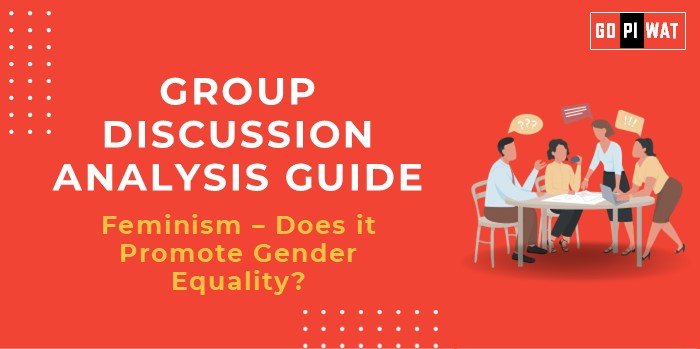📋 Group Discussion (GD) Analysis Guide on “Feminism – Does it Promote Gender Equality?”
🌐 Introduction to Feminism and Gender Equality
Context Setting: Feminism, a global movement advocating for the rights and equality of women, has roots in the early 20th century and has evolved to address complex social, political, and economic inequalities.
Topic Background: Originally focused on women’s suffrage and equal rights, modern feminism now tackles issues of systemic bias, gender representation, and workplace parity. Recent years have seen discussions on whether feminism aligns fully with gender equality or if it has become more exclusive in scope.
📊 Quick Facts and Key Statistics
- 🌍 Global Gender Gap: As of 2023, the World Economic Forum estimates the global gender gap at 68.1% closed, with predictions suggesting over 130 years to achieve full parity.
- 💼 Workforce Participation: Women represent 47% of the global workforce, yet earn only 77% of what men make for similar work.
- ⚠️ Violence Against Women: The WHO reports that 1 in 3 women globally experience physical or sexual violence, highlighting a significant gap in gender-based safety and justice.
- 📚 Education Gap: Girls are still 2.5 times more likely to be out of school compared to boys in regions like Sub-Saharan Africa, showing ongoing education inequality.
👥 Stakeholders and Their Roles
- 🏛️ Governments and Policy Makers: Establish and enforce gender equality laws and initiatives.
- 🤝 NGOs and Activists: Advocate for women’s rights and raise awareness on gender issues.
- 🏢 Private Sector and Employers: Play a key role in achieving workplace parity, fair wages, and representation.
- 📚 Educational Institutions: Educate on gender equality and provide equal opportunities.
- 👥 Citizens and Society: Uphold and challenge gender norms and cultural stereotypes.
🎯 Achievements and Challenges
🏆 Achievements:
- 👩⚖️ Increased Political Representation: More women are now in political positions, with nations like New Zealand and Finland led by female heads of state.
- 🏢 Workplace Inclusion Policies: Many global companies now enforce diversity and equal pay policies, leading to higher female workforce participation.
- ⚖️ Legal Reforms: Countries have passed gender equality laws, improving rights and protections for women.
⚠️ Challenges:
- 💰 Persistent Gender Pay Gap: Despite advancements, pay disparity persists globally.
- 🌍 Cultural Resistance: In many regions, traditional gender norms resist feminist ideals.
- ⚡ Intersectional Inequality: Marginalized groups within the feminist movement face additional discrimination.
Global Comparisons: Countries like Iceland, ranked the most gender-equal country, enforce equal pay policies, whereas Japan faces criticism for slow progress, with women holding only 14% of managerial roles.
🗣️ Structured Arguments for Discussion
✅ Supporting Stance:
“Feminism actively promotes gender equality by breaking down systemic barriers in the workforce and increasing legal protections for women.”
❌ Opposing Stance:
“Feminism has shifted towards women-centric issues, occasionally neglecting the broader needs of other genders and hence no longer fully supports true gender equality.”
⚖️ Balanced Perspective:
“While feminism has successfully increased women’s rights and representation, it may benefit from a more inclusive, gender-neutral approach to fully promote equality.”
💡 Effective Discussion Approaches
🔑 Opening Approaches:
- 📊 Statistical Opener: “Despite a global push for gender equality, the gender gap is expected to persist for over a century.”
- 📜 Quote-Based Opener: “As author Chimamanda Ngozi Adichie says, ‘We should all be feminists,’ but what does this mean for gender equality today?”
⚡ Counter-Argument Handling:
- Discuss initiatives that include men’s issues within feminism, such as UN Women’s “HeForShe” campaign.
- Highlight how intersectionality addresses challenges for marginalized groups.
🔎 Strategic Analysis of Strengths and Weaknesses (SWOT)
- 💪 Strengths: Progress in education, political participation, legal protections.
- ⚡ Weaknesses: Intersectional inclusivity, persistent wage gap.
- 🌟 Opportunities: Increased advocacy for marginalized genders, stronger equality legislation.
- ⚠️ Threats: Backlash in conservative societies, misunderstanding of feminism’s goals.
🏫 Connecting with B-School Applications
📖 Real-World Applications:
This topic aligns with B-school studies on workplace diversity, human resources policies, and corporate social responsibility.
📋 Sample Interview Questions:
- “How would you address gender inequality in the corporate environment?”
- “Do you think a gender-neutral approach is better for achieving equality?”
Insights for B-School Students: This discussion encourages future leaders to create inclusive workplaces, consider diverse perspectives, and advocate for equal opportunities across genders.


